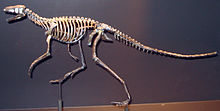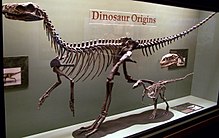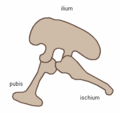Origins and early evolution
For a long time many scientists thought dinosaurs were polyphyletic with multiple groups of unrelated "dinosaurs" evolving due to similar pressures, but dinosaurs are now known to have formed a single group.
Dinosaurs diverged from their archosaur ancestors approximately 230 million years ago during the Middle to Late Triassic period, roughly 20 million years after the Permian–Triassic extinction event wiped out an estimated 95% of all life on Earth. Radiometric dating of the rock formation that contained fossils from the early dinosaur genus Eoraptor establishes its presence in the fossil record at this time. Paleontologists believe Eoraptor resembles the common ancestor of all dinosaurs; if this is true, its traits suggest that the first dinosaurs were small, bipedal predators. The discovery of primitive, dinosaur-like ornithodirans such as Marasuchus and Lagerpeton in Argentinian Middle Triassic strata supports this view; analysis of recovered fossils suggests that these animals were indeed small, bipedal predators.
When dinosaurs appeared, terrestrial habitats were occupied by various types of basal archosaurs and therapsids, such as aetosaurs, cynodonts, dicynodonts, ornithosuchids, rauisuchias, and rhynchosaurs. Most of these other animals became extinct in the Triassic, in one of two events. First, at about the boundary between the Carnian and Norian faunal stages (about 215 million years ago), dicynodonts and a variety of basal archosauromorphs, including the prolacertiforms and rhynchosaurs, became extinct. This was followed by the Triassic–Jurassic extinction event (about 200 million years ago), that saw the end of most of the other groups of early archosaurs, like aetosaurs, ornithosuchids, phytosaurs, and rauisuchians. These losses left behind a land fauna of crocodylomorphs, dinosaurs, mammals, pterosaurians, and turtles.
The first few lines of primitive dinosaurs diversified through the Carnian and Norian stages of the Triassic, most likely by occupying the niches of groups that became extinct. Traditionally, dinosaurs were thought to have replaced the variety of other Triassic land animals by proving superior through a long period of competition. This now appears unlikely, for several reasons. Dinosaurs do not show a pattern of steadily increasing in diversity and numbers, as would be predicted if they were competitively replacing other groups; instead, they were very rare through the Carnian, making up only 1–2% of individuals present in faunas. In the Norian, however, after the extinction of several other groups, they became significant components of faunas, representing 50–90% of individuals. Also, what had been viewed as a key adaptation of dinosaurs, their erect stance, is now known to have been present in several contemporaneous groups that were not as successful (aetosaurs, ornithosuchids, rauisuchians, and some groups of crocodylomorphs). Finally, the Late Triassic itself was a time of great upheaval in life, with shifts in plant life, marine life, and climate. Crurotarsans, today represented only by crocodilians but in the Late Triassic also encompassing such now-extinct groups as aetosaurs, phytosaurs, ornithosuchians, and rauisuchians, were actually more diverse in the Late Triassic than dinosaurs, indicating that the survival of dinosaurs had more to do with luck than superiority.
Low diversification in the Cretaceous
Statistical analyses based on raw data suggest that dinosaurs diversified, i.e. the number of species increased, in the Late Cretaceous. However in July 2008 Graeme T. Lloyd et al. argued that this apparent diversification was an illusion caused by sampling bias, because Late Cretaceous rocks have been very heavily studied. Instead, they wrote, dinosaurs underwent only two significant diversifications in the Late Cretaceous, the initial radiations of the euhadrosaurs and ceratopsians. In the Mid Cretaceous, the flowering angiosperm plants became a major part of terrestrial ecosystems, which had previous been dominated by gymnosperms such as conifers. Dinosaur coprolites (fossilized dung) indicate that, while some ate angiosperms, most herbivorous dinosaurs mainly ate gymnosperms. Meanwhile herbivorous insects and mammals diversified rapidly to take advantage of the new type of plant food, while lizards, snakes, crocodilians and birds also diversified at the same time. Lloyd et al. suggest that dinosaurs' failure to diversify as ecosystems were changing doomed them to extinction.Classification
Dinosaurs (including birds) are archosaurs, like modern crocodilians. Archosaurs' diapsid skulls have two holes, called temporal fenestrae, located where the jaw muscles attach, and an additional antorbital fenestra in front of the eyes. Most reptiles (including birds) are diapsids; mammals, with only one temporal fenestra, are called synapsids; and turtles, with no temporal fenestra, are anapsids. Anatomically, dinosaurs share many other archosaur characteristics, including teeth that grow from sockets rather than as direct extensions of the jawbones. Within the archosaur group, dinosaurs are differentiated most noticeably by their gait. Dinosaur legs extend directly beneath the body, whereas the legs of lizards and crocodilians sprawl out to either side.Collectively, dinosaurs are usually regarded as a superorder or an unranked clade. They are divided into two orders, Saurischia and Ornithischia, depending upon pelvic structure. Saurischia includes those taxa sharing a more recent common ancestor with birds than with Ornithischia, while Ornithischia includes all taxa sharing a more recent common ancestor with Triceratops than with Saurischia. Saurischians ("lizard-hipped", from the Greek sauros (σαυρος) meaning "lizard" and ischion (ισχιον) meaning "hip joint") retained the hip structure of their ancestors, with a pubis bone directed cranially, or forward. This basic form was modified by rotating the pubis backward to varying degrees in several groups (Herrerasaurus, therizinosauroids, dromaeosaurids, and birds). Saurischia includes the theropods (bipedal and mostly carnivores, except for birds) and sauropodomorphs (long-necked quadrupedal herbivores).
By contrast, ornithischians ("bird-hipped", from the Greek ornitheios (ορνιθειος) meaning "of a bird" and ischion (ισχιον) meaning "hip joint") had a pelvis that superficially resembled a bird's pelvis: the pubis bone was oriented caudally (rear-pointing) Unlike birds, the ornithischian pubis also usually had an additional forward-pointing process. Ornithischia includes a variety of herbivores. (NB: the terms "lizard hip" and "bird hip" are misnomers – birds evolved from dinosaurs with "lizard hips".)
Saurischian pelvis structure (left side) | Tyrannosaurus pelvis (showing saurischian structure – left side) | Ornithischian pelvis structure (left side) | Edmontosaurus pelvis (showing ornithischian structure – left side) |

Several macronarian Sauropods: from left to right Camarasaurus, Brachiosaurus, Giraffatitan, and Euhelopus

Various ornithopod dinosaurs and one heterodontosaurid. Far left: Camptosaurus, left: Iguanodon, center background: Shantungosaurus, center foreground: Dryosaurus, right: Corythosaurus, far right (small): Heterodontosaurus, far right (large) Tenontosaurus.
- Dinosauria
- Saurischia (theropods and sauropods)
- †Herrerasaurians (early bipedal predators)
- Theropods (all bipedal; most were carnivores)
- †Coelophysoids (Coelophysis and close relatives)
- †Ceratosaurians (Ceratosaurus and abelisaurids – the latter were important Late Cretaceous predators in southern continents)
- †Spinosauroids (long bodies; short arms; some with crocodile-like skulls and bony "sails" on their backs)
- †Carnosaurians (Allosaurus and close relatives, like Carcharodontosaurus)
- Coelurosaurians (diverse, with a range of body sizes and niches)
- †Tyrannosauroids (small to gigantic, often with reduced forelimbs)
- †Ornithomimosaurians ("ostrich-mimics"; mostly toothless; carnivores to possible herbivores)
- †Therizinosauroids (bipedal herbivores with large hand claws and small heads)
- †Oviraptorosaurians (mostly toothless; their diet and lifestyle are uncertain)
- †Dromaeosaurids (popularly known as "raptors"; bird-like carnivores)
- †Troodontids (similar to dromaeosaurids, but more lightly built)
- Avialans (flying dinosaurs, including modern birds: the only living dinosaurs)
- †Sauropodomorphs (quadrupedal herbivores with small heads, long necks and tails, and elephant-like bodies)
- †"Prosauropods" (early relatives of sauropods; small to quite large; some possibly omnivorous; bipeds and quadrupeds)
- †Sauropods (very large, usually over 15 meters long [49 ft])
- †Diplodocoids (skulls and tails elongated; teeth typically narrow and pencil-like)
- †Macronarians (boxy skulls; spoon-shaped or pencil-shaped teeth)
- †Brachiosaurids (very long necks; forelimbs longer than hindlimbs)
- †Titanosaurians (diverse; stocky, with wide hips; most common in the Late Cretaceous of southern continents)
- †Ornithischians (diverse bipedal and quadrupedal herbivores)
- †Heterodontosaurids (meter- or yard-scale herbivores or omnivores with prominent canine teeth)
- †Thyreophorans (armored dinosaurs; mostly quadrupeds)
- †Ankylosaurians (scutes as primary armor; some had club-like tails)
- †Stegosaurians (spikes and plates as primary armor)
- †Ornithopods (diverse, from meter- or yard-scale bipeds to 12-meter (39 ft) animals that could move as both bipeds and quadrupeds; evolved a method of chewing using skull flexibility and large numbers of teeth)
- †Hadrosaurids ("duckbilled dinosaurs")
- †Pachycephalosaurians ("bone-heads"; bipeds with domed or knobby growth on skulls)
- †Ceratopsians (dinosaurs with horns and frills, although most early forms had only the beginnings of these features)
Evolution and paleobiogeography
Dinosaur evolution after the Triassic follows changes in vegetation and the location of continents. In the Late Triassic and Early Jurassic, the continents were connected as the single landmass Pangaea, and there was a worldwide dinosaur fauna mostly composed of coelophysoid carnivores and prosauropod herbivores. Gymnosperm plants (particularly conifers), a potential food source, radiated in the Late Triassic. Prosauropods did not have sophisticated mechanisms for processing food in the mouth, and so must have employed other means of breaking down food farther along the digestive tract. The general homogeneity of dinosaurian faunas continued into the Middle and Late Jurassic, where most localities had predators consisting of ceratosaurians, spinosauroids, and carnosaurians, and herbivores consisting of stegosaurian ornithischians and large sauropods. Examples of this include the Morrison Formation of North America and Tendaguru Beds of Tanzania. Dinosaurs in China show some differences, with specialized sinraptorid theropods and unusual, long-necked sauropods like Mamenchisaurus. Ankylosaurians and ornithopods were also becoming more common, but prosauropods had become extinct. Conifers and pteridophytes were the most common plants. Sauropods, like the earlier prosauropods, were not oral processors, but ornithischians were evolving various means of dealing with food in the mouth, including potential cheek-like organs to keep food in the mouth, and jaw motions to grind food. Another notable evolutionary event of the Jurassic was the appearance of true birds, descended from maniraptoran coelurosaurians.By the Early Cretaceous and the ongoing breakup of Pangaea, dinosaurs were becoming strongly differentiated by landmass. The earliest part of this time saw the spread of ankylosaurians, iguanodontians, and brachiosaurids through Europe, North America, and northern Africa. These were later supplemented or replaced in Africa by large spinosaurid and carcharodontosaurid theropods, and rebbachisaurid and titanosaurian sauropods, also found in South America. In Asia, maniraptoran coelurosaurians like dromaeosaurids, troodontids, and oviraptorosaurians became the common theropods, and ankylosaurids and early ceratopsians like Psittacosaurus became important herbivores. Meanwhile, Australia was home to a fauna of basal ankylosaurians, hypsilophodonts, and iguanodontians. The stegosaurians appear to have gone extinct at some point in the late Early Cretaceous or early Late Cretaceous. A major change in the Early Cretaceous, which would be amplified in the Late Cretaceous, was the evolution of flowering plants. At the same time, several groups of dinosaurian herbivores evolved more sophisticated ways to orally process food. Ceratopsians developed a method of slicing with teeth stacked on each other in batteries, and iguanodontians refined a method of grinding with tooth batteries, taken to its extreme in hadrosaurids. Some sauropods also evolved tooth batteries, best exemplified by the rebbachisaurid Nigersaurus.
There were three general dinosaur faunas in the Late Cretaceous. In the northern continents of North America and Asia, the major theropods were tyrannosaurids and various types of smaller maniraptoran theropods, with a predominantly ornithischian herbivore assemblage of hadrosaurids, ceratopsians, ankylosaurids, and pachycephalosaurians. In the southern continents that had made up the now-splitting Gondwana, abelisaurids were the common theropods, and titanosaurian sauropods the common herbivores. Finally, in Europe, dromaeosaurids, rhabdodontid iguanodontians, nodosaurid ankylosaurians, and titanosaurian sauropods were prevalent. Flowering plants were greatly radiating, with the first grasses appearing by the end of the Cretaceous. Grinding hadrosaurids and shearing ceratopsians became extremely diverse across North America and Asia. Theropods were also radiating as herbivores or omnivores, with therizinosaurians and ornithomimosaurians becoming common.
The Cretaceous–Tertiary extinction event, which occurred approximately 65 million years ago at the end of the Cretaceous period, caused the extinction of all dinosaurs except for the birds. Some other diapsid groups, such as crocodilians, lizards, snakes, sphenodontians, and choristoderans, also survived the event






0 comments:
Post a Comment